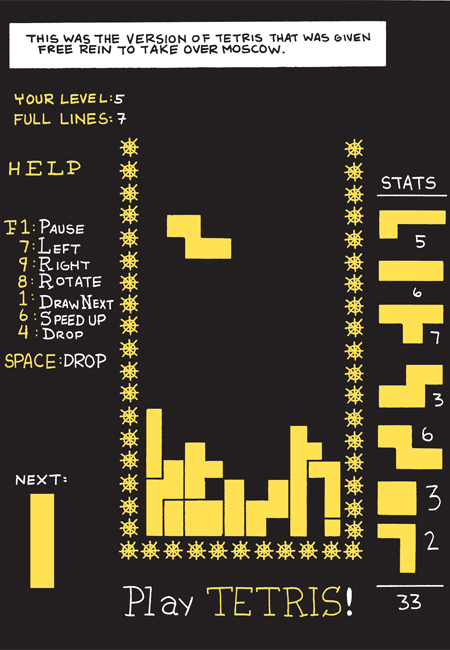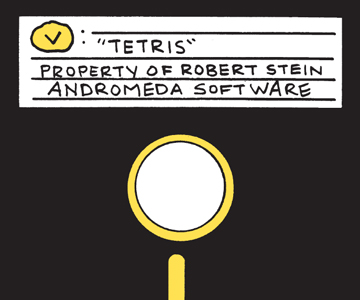This Article From Issue
January-February 2017
Volume 105, Number 1
THE TETRIS EFFECT: The Game that Hypnotized the World. Dan Ackerman. 272 pp. Public Affairs, 2016. $25.99.
TETRIS: The Games People Play. Box Brown. 256 pp. First Second, 2016. $19.99.
What is it about Tetris? How did this inspired little game, which started out as a piece of freeware designed to run on the Russian Electronica 60 Microcomputer, transform into an international bestseller generating billions of dollars? Thereby hangs a tale—and 30 years on, two books have appeared to tell it. The Tetris Effect, by technology journalist Dan Ackerman, and Tetris, by Ignatz Award–winning cartoonist Box Brown, hit bookstore shelves within months of each other. Yet each ushers readers along a distinct and enlightening path.

The story behind the pioneering game Tetris is complex, spanning the worlds of technology, psychology, entertainment, politics, and business. Still, the core narrative is in some ways familiar. A videogame phenomenon emerges maybe once or twice a decade: It appears to come out of nowhere; then all at once everyone seems to be playing it. Pac-Man, Myst, Farmville, The Sims, Angry Birds, and Candy Crush are among a short list of games that became household words, acquired hundreds of millions of players, and generated billions in revenue. When Tetris exploded onto the gaming scene in the late 1980s, it did all these things too. At the same time, its impossible simplicity made it stand apart.
The game of Tetris has no luscious artwork, no characters, no story, no social features, no set of painstakingly hand-crafted puzzle levels. The gameplay is nothing more than this: Seven blocks, arranged in a handful of predetermined shapes, descend one by one onto a 10-block by 20-block grid as a player tries to rotate the shapes neatly into place, making room for more. Gradually the shapes fall faster, then faster yet until the grid fills and the game ends. That’s it.
The game was invented in 1984, but there was no technological reason it couldn’t have been created years earlier. The Atari 2600, for example, released in 1978, was a powerful enough system to run a game like Tetris—and had Tetris existed, it could easily have been the most addictive and popular game for the 2600. But that didn’t happen of course, because no one had thought of a game anything like Tetris.
Something about Tetris makes it fit like a key into the lock that is the human mind.
The one who did think of it was Alexey Pajitnov, a Russian computer scientist who was supposed to be working on artificial intelligence projects. Instead, he kept thinking about how to make a computer version of the beloved pentominoes game he grew up playing. Pentominoes are puzzle pieces, each composed of five squares presented in one of 12 different configurations. But the notion of recreating these classic wooden puzzle pieces within a computer game was a little overwhelming. Then it occurred to Pajitnov that he could simplify the pieces into tetrominoes, which would have only four squares each, for a total of seven unique pieces. He set to work creating the game, but early versions (fashioned under the less appealing title “Genetic Engineering”), which simply allowed a player to arrange the tetrominoes freely in a rectangle, were dull and static.
But a moment of inspiration changed the playing experience entirely: Pajitnov added time pressure. Tetrominoes would fall one after another from the top of the screen; whenever tetrominoes were rotated and nudged into place to fill a 10-block row of the grid, that row of blocks would disappear, freeing space for more blocks and enabling the game to continue a little longer. This mixture—a spatial puzzler intensified by time pressure—turned out to be addictive. Pajitnov could hardly stop playing. When he showed the game to his colleagues, they were skeptical at first. Yet one by one, they too found themselves caught in the compulsion loop that Tetris generates in almost everyone who plays it.
What exactly makes Tetris so compelling is a matter of much debate. For example, in his book Brown addresses the question through a discussion of Bluma Zeigarnik and Kurt Lewin’s research on how certain kinds of tension stimulate the prefrontal cortex. Ackerman first discusses the pharmatronic (mind-altering states induced by interaction with technology) qualities of various technology experiences, such as “the dopamine hit upon receiving a new ‘like’” on social media. Then he homes in on Tetris’s rhythm and timing: “The pharmatronic effect of Tetris is better explained by the hypnotic rhythms of the game and its simple, geometric patterns, with the constant stream of immediate closed-loop feedback hooking unconscious triggers into the waking mind.”

Whatever the cause, something about this particular game makes it fit like a key into the lock that is the human mind. It is not simply a matter of puzzle pieces, time pressure, and gradual progress alone; many games have these, yet none have had the addictive staying power of Tetris. It has remained popular for decades, holding the Guinness World Record for the most ported videogame, meaning that it has been officially translated onto more than 65 computer game platforms, including mobile phones. And although there have been hundreds of attempts to add new features, rules, and twists in an effort to improve the game, not one of them has lasted. In every case, the new rules and features make for a version that is less elegant and less captivating than the original.
But the game’s uniqueness is only part of the tale. Because the game’s creator was a government employee of the Soviet Union who crafted the game on the job, using his employer’s computers, Tetris itself belonged to the Motherland. When word of the game trickled out to the West, career bureaucrats found themselves pitted against envoys from an array of technology companies vying for the game’s international commercial rights. Fitting together the many individuals involved in the worldwide spread of Tetris is a bit of a Tetris game itself, involving scientists, inventors, entrepreneurs, coders, government agents, and marketers from Russia, Hungary, the United States, the United Kingdom, and Japan.
In The Tetris Effect, Ackerman tells the story as straightforwardly as possible, introducing the key individuals and unravelling the complex tale of the game’s invention and spread. Initially shared for free, a copy of Tetris found its way to Hungary, where it was discovered by software distributor Robert Stein, who sought out the first distribution license for the game. Unfortunately for Stein, vagueness in his licensing contract and confusion in communicating with the Soviet government, the owner the game, left the door open for others (including Atari and Nintendo) to receive competing licenses, or at least to think they had. What follows is a dramatic story involving multiple competing software companies, each grappling for control of a piece of software so simple that it can be coded with just 1 kilobyte of javascript, but that seizes and holds the human mind in a way that had never been seen before.
Who would win the battle for Tetris was a matter of not only persuasive personalities, but who could best deal with the reality that inventions such as the Nintendo Entertainment System and the Game Boy were redefining what the term computing device even meant. Each new invention blew previous contracts to shreds. Ackerman deftly weaves together these stories of invention, legal wrangling, and savvy salesmanship. Along the way he shares asides about the many psychological studies that have brought Tetris into the lab and what they have taught us about the human mind. Researchers have, for example, used the game to study energy consumption in the brain and to explore possible therapies for treating post-traumatic stress syndrome.
Brown’s book Tetris tells the same story in a radically different way, conveying the game’s history in the style of a graphic novel. This approach may seem counterintuitive, especially for a story in which much of the action takes place in meeting rooms and in front of computer screens. Yet I found Tetris to be one of the most inspiring works of videogame history I have ever read. Most stories of game development center on genius and success. As a game developer myself, however, I can tell you that the actual work isn’t like that. Game development is lonely and difficult, and Brown’s book captures this perfectly. But it also shows that success comes from persisting in your passion to create something wonderful, even when (especially when) it seems crazy to the rest of the world.

The book’s format, as well as Brown’s uncluttered style, prevents this version of the story from going into the detail of Ackerman’s book, so some complex aspects are glossed over. But in presenting a tale of multiple cultures, dynamic personalities, and interlocking puzzle pieces, the graphic novel format has many advantages. It is far easier to grasp the evolution of the game by seeing illustrations of prototypes, and seeing the faces of the many individuals involved in the story makes it much easier to keep track of who is who. Moreover, Brown has a knack for illuminating the motivations of his real-life characters. Arguably the true hero of Brown’s story is Gunpei Yokoi, creator of the Game Boy. Without his unceasing spirit of invention, the world of both videogames and mobile devices would be much less advanced today.
As an artist, Brown also brings a new dimension to the story: the game of Tetris as a work of art. He makes a persuasive argument throughout the book for viewing games as art and their creators as artists. As such, Pajitnov’s puzzle game has reached a rarefied status. A revolutionary work, “Tetris was essential to the development of the art form. These puzzle pieces,” he observes of the tetraminoes, “have become canon.”
The books differ on certain points (for example, Brown submits that Pajitnov had no real desire to make money from his game, whereas Ackerman suggests otherwise), but they complement each other nicely. Just as two stereoscopic images help us see a three-dimensional picture, together these two books provide a depth of insight impossible to gain from just one point of view. I read Brown’s book first and found that it served as an excellent lead-in to Ackerman’s more detailed work.
Pajitnov’s Tetris has been with us for a generation, yet these books show how it continues to mystify and surprise us. And given how easily the game continues to transfer to new technologies, it will likely be with us for generations to come.




American Scientist Comments and Discussion
To discuss our articles or comment on them, please share them and tag American Scientist on social media platforms. Here are links to our profiles on Twitter, Facebook, and LinkedIn.
If we re-share your post, we will moderate comments/discussion following our comments policy.